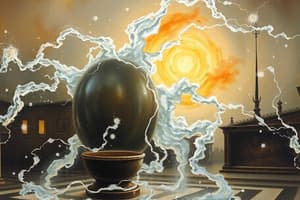Podcast
Questions and Answers
Which fundamental force is responsible for the stability of atomic nuclei?
Which fundamental force is responsible for the stability of atomic nuclei?
- Gravitational Force
- Weak Nuclear Force
- Electromagnetic Force
- Strong Nuclear Force (correct)
The acceleration of an object is inversely proportional to the mass according to Newton's Second Law.
The acceleration of an object is inversely proportional to the mass according to Newton's Second Law.
True (A)
What is the formula for kinetic energy?
What is the formula for kinetic energy?
KE = 1/2 mv²
The principle that the total momentum before and after an event remains constant is called the __________.
The principle that the total momentum before and after an event remains constant is called the __________.
Match the following laws of thermodynamics with their descriptions:
Match the following laws of thermodynamics with their descriptions:
Which of the following describes the behavior of waves when they overlap?
Which of the following describes the behavior of waves when they overlap?
Ohm's Law states that voltage is directly proportional to current and resistance.
Ohm's Law states that voltage is directly proportional to current and resistance.
What is the speed of light in a vacuum?
What is the speed of light in a vacuum?
Flashcards are hidden until you start studying
Study Notes
Key Concepts in Physics
-
Fundamental Forces
- Gravitational Force: Attraction between masses.
- Electromagnetic Force: Interaction between charged particles.
- Strong Nuclear Force: Holds the nucleus together.
- Weak Nuclear Force: Responsible for radioactive decay.
-
Newton's Laws of Motion
- First Law (Inertia): An object at rest stays at rest, and an object in motion stays in motion unless acted upon by a net external force.
- Second Law (F=ma): The acceleration of an object is directly proportional to the net force acting on it and inversely proportional to its mass.
- Third Law (Action-Reaction): For every action, there is an equal and opposite reaction.
-
Energy Types
- Kinetic Energy: Energy of motion (KE = 1/2 mv²).
- Potential Energy: Stored energy based on position (PE = mgh in a gravitational field).
- Mechanical Energy: Sum of potential and kinetic energy.
- Thermal Energy: Related to temperature and motion of particles.
-
Conservation Laws
- Conservation of Energy: Energy cannot be created or destroyed, only transformed.
- Conservation of Momentum: In a closed system, the total momentum before and after an event remains constant.
-
Waves and Oscillation
- Wave Properties: Wavelength, frequency, amplitude, speed.
- Types of Waves: Longitudinal (e.g., sound) and transverse (e.g., light).
- Superposition: The principle that when two or more waves overlap, the resultant wave is the sum of the individual waves.
-
Thermodynamics
- Laws of Thermodynamics:
- Zeroth Law: If two systems are in thermal equilibrium with a third system, they are in thermal equilibrium with each other.
- First Law: Energy cannot be created or destroyed (conservation of energy).
- Second Law: Entropy of an isolated system always increases; heat flows from hot to cold.
- Third Law: As temperature approaches absolute zero, the entropy of a perfect crystal approaches zero.
- Laws of Thermodynamics:
-
Electricity and Magnetism
- Ohm's Law: V = IR (Voltage = Current × Resistance).
- Coulomb's Law: The electric force between two charges is proportional to the product of the charges and inversely proportional to the square of the distance between them.
- Electromagnetic Induction: Changing magnetic fields can induce an electric current.
-
Relativity
- Special Relativity: Proposes that the laws of physics are the same for all non-accelerating observers and that the speed of light is constant.
- General Relativity: Describes gravity as a curvature of spacetime caused by mass.
-
Quantum Mechanics
- Wave-Particle Duality: Particles exhibit both wave-like and particle-like properties.
- Uncertainty Principle: It is impossible to simultaneously know the exact position and momentum of a particle.
- Quantum States: Systems exist in probability states until measured.
Important Formulas
- Force: F = ma
- Work: W = Fd (Work = Force × Distance)
- Power: P = W/t (Power = Work done / time)
- Momentum: p = mv (Momentum = mass × velocity)
- Acceleration: a = (vf - vi) / t (where vf = final velocity, vi = initial velocity)
Fundamental Forces
- Gravitational Force: Attracts objects with mass towards each other, influencing planets' orbits and the formation of stars.
- Electromagnetic Force: Governs the interaction of charged particles, responsible for electricity, magnetism, and light.
- Strong Nuclear Force: Holds the protons and neutrons together in the nucleus of an atom, overcoming electrostatic repulsion between protons.
- Weak Nuclear Force: Responsible for radioactive decay, allowing neutrons to transform into protons, affecting nuclear processes.
Newton's Laws of Motion
- First Law (Inertia): Objects at rest stay at rest, and objects in motion stay in motion at constant velocity unless acted upon by a net external force.
- Second Law (F=ma): The acceleration of an object is directly proportional to the net force acting on it and inversely proportional to its mass. This quantifies how force affects motion.
- Third Law (Action-Reaction): For every action, there is an equal and opposite reaction. When you push against the ground, the ground pushes back on you with equal force.
Energy Types
- Kinetic Energy: The energy an object possesses due to its motion.
- Potential Energy: Stored energy based on an object's position or configuration.
- Mechanical Energy: The sum of an object's kinetic and potential energy.
- Thermal Energy: Related to the internal energy of a system, determined by the temperature and motion of its particles.
Conservation Laws
- Conservation of Energy: Energy cannot be created or destroyed, only transformed from one form to another.
- Conservation of Momentum: In a closed system, the total momentum before and after an event remains constant. Momentum is the product of mass and velocity.
Waves and Oscillations
-
Wave Properties:
- Wavelength: The distance between two crests or troughs of a wave.
- Frequency: The number of waves passing a point per second.
- Amplitude: The maximum displacement of a wave from its equilibrium position.
- Speed: The distance a wave travels per unit time.
-
Types of Waves:
- Longitudinal Waves: Oscillations parallel to the direction of wave propagation (e.g., sound).
- Transverse Waves: Oscillations perpendicular to the direction of wave propagation (e.g., light).
-
Superposition: When two or more waves overlap, the resultant wave is the sum of the individual waves.
Thermodynamics
- Laws of Thermodynamics:
- Zeroth Law: Two systems in thermal equilibrium with a third system are in thermal equilibrium with each other.
- First Law: Energy cannot be created or destroyed, only transformed, consistent with the conservation of energy principle.
- Second Law: Entropy of an isolated system always increases over time. Heat flows spontaneously from hot to cold objects.
- Third Law: As temperature approaches absolute zero, the entropy of a perfect crystal approaches zero. Entropy is a measure of disorder in a system.
Electricity and Magnetism
- Ohm's Law: Relates voltage, current, and resistance in a circuit: V = IR (Voltage = Current × Resistance).
- Coulomb's Law: Describes the force between two charged particles - the force is directly proportional to the product of the charges and inversely proportional to the square of the distance between them.
- Electromagnetic Induction: Changing magnetic fields can induce an electric current, the principle behind generators and transformers.
Relativity
- Special Relativity: Proposes that the laws of physics are the same for all non-accelerating observers and that the speed of light is constant (approximately 300,000 km/s) regardless of the observer's motion.
- General Relativity: Explains gravity as a curvature of spacetime caused by mass. Gravity is not a force but a consequence of the geometry of space and time.
Quantum Mechanics
- Wave-Particle Duality: Particles exhibit both wave-like and particle-like properties. Light, for example, can act as both a wave and a particle, which is a fundamental concept in quantum physics.
- Uncertainty Principle: It is impossible to simultaneously know both the exact position and momentum of a particle. The more precisely you know one, the less precisely you can know the other.
- Quantum States: In quantum mechanics, systems exist in probability states until measured. The act of measurement forces the system to collapse into a definite state.
Studying That Suits You
Use AI to generate personalized quizzes and flashcards to suit your learning preferences.




